Vizio Thin+Light CT15: Something New and Edgy
by Vivek Gowri on February 14, 2013 9:00 AM EST- Posted in
- Laptops
- Intel
- IPS
- Ivy Bridge
- Vizio
- Ultraportable
- Ultrabook
The display is actually what every single mid-to-high end 15” notebook should aim to ship with. It’s a matte 15.6” 1080p IPS panel made by LG, and it looks awesome. It actually shares the same panel as the HP Envy 15, with a close variant of this panel being used by Sony with the SE series that Jarred reviewed as well as ASUS in the new UX51. It's not necessarily perfect, but it's so far ahead of the most other laptops panels that it may as well be.
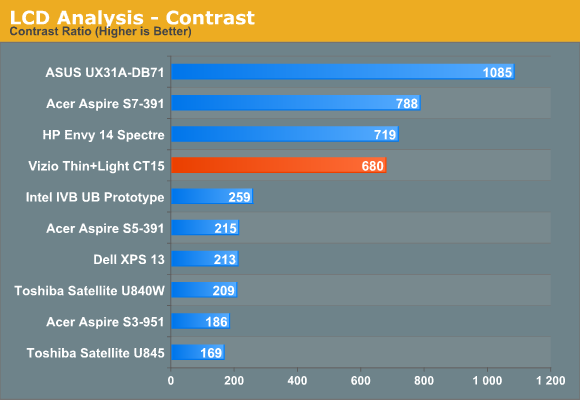
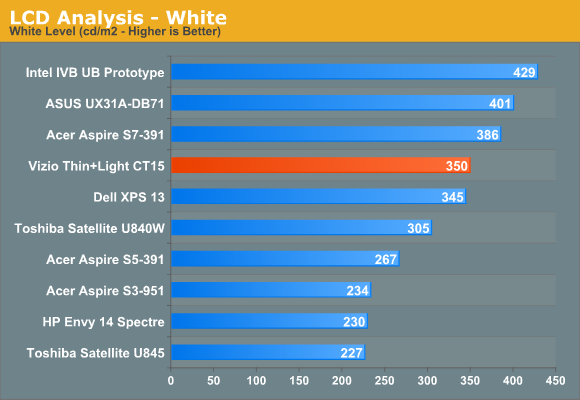
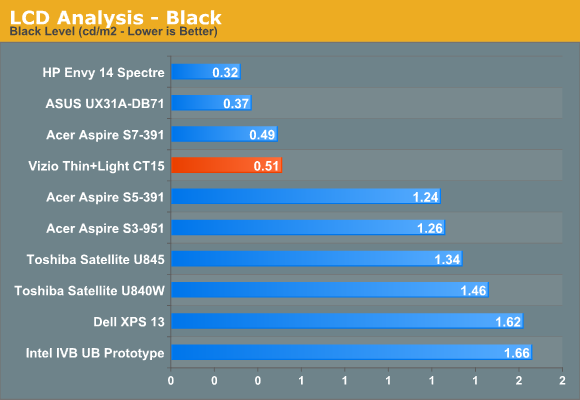
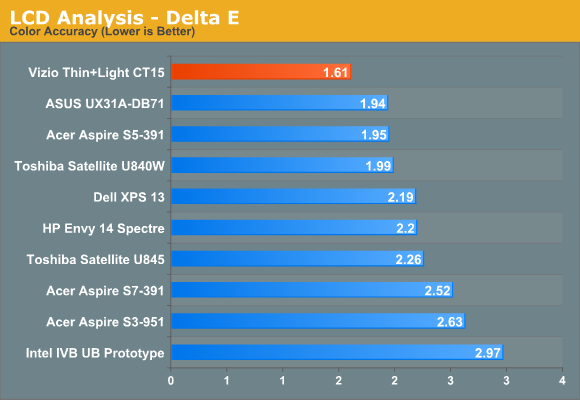
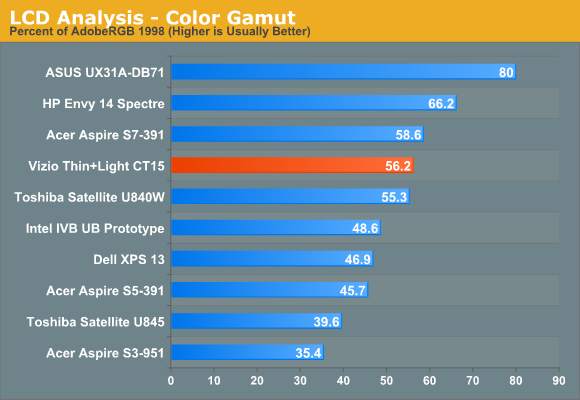
It doesn’t necessarily have the best contrast ratio, though at nearly 700:1 it’s certainly good, but the backlight is strong (350 nit maximum brightness), the matte finish is awesome, and color reproduction is very good. 1080p at 15.6” is essentially the perfect pixel density for a good amount of screen real estate, without making everything too small for comfortable viewing. It’s just really pleasing to the eye. I love it, and it makes up for a lot of the other flaws—every time the keyboard gets on my nerves, I remember how fantastic this display is. It’s just that compelling.
Now, it’s obviously not a touchscreen, and how much that bothers you depends on how much you value melding the traditional clamshell form factor with a touchscreen, and how much that impacts your Windows 8 experience. For me personally, touchscreens stop being useful on notebooks larger than 13”. Any larger than that, and my typical viewing distance is far enough away for it to be a bit uncomfortable to reach out and touch the screen. Not that I couldn’t do it if I wanted, but it’s an actual effort with larger notebooks where it’s almost second nature to use the touchscreen for navigation on 11.6” systems. The line for me is at 13”—anything larger than that, and the amount I use the touchscreen in day-to-day use goes down significantly.
Even though I didn’t particularly miss the touchscreen with the Vizio, all Vizio PCs going forward will have touchscreen displays, including the next revision of the Thin+Light line that we’ve already had a chance to play with. From our brief interaction with it, it seemed like a high quality display, though I’m not sure how much the user experience will change. Portable Windows 8 systems are still undergoing rapid form factor iterations, and manufacturers are still working on finding the sweetspots in the range. I’m not sure that touchscreens have value in large notebooks, but I’m willing to be proven wrong on this.










55 Comments
View All Comments
tipoo - Thursday, February 14, 2013 - link
More cache too I believe.Death666Angel - Friday, February 15, 2013 - link
3MB on i5 vs 4MB on i7, yes.xaml - Saturday, February 16, 2013 - link
In a Freudian slip of sorts, Dell put an i5 sticker on my XPS 14 (2012) powered by an i7.StephaneP - Thursday, February 14, 2013 - link
It's all in the subject. I'm surprised that these informations are not in this review.tipoo - Thursday, February 14, 2013 - link
With the Windows 8 multitouch driver, I have zero problems with the touchpad on my 3 year old Dell Studio 15, actually it's pretty good. It's not Mac good, but I'd say something like 80% as good which is good enough for me. The bad input rejection is just right, there is smooth scrolling throughout the OS, good pinch to zoom, etc etc.So would all Vizios you could order now have a Synaptics pad instead of the horrid old one? How can we make sure?
VivekGowri - Thursday, February 14, 2013 - link
All of the Windows 7 ones came with Sentelic touchpads (CT15-A0, A1, A2), while the Windows 8 ones have Synaptics touchpads (A4, A5). A small, but very important, hardware update that came at the same time as the Windows 8 refresh.tipoo - Thursday, February 14, 2013 - link
Awesome, thanks.PEJUman - Thursday, February 14, 2013 - link
I have the following systems: 48GB in x58 970, 16GB on H77 3770, 8GB on P45 Q9650, 8GB on Hudson (AMD C-60) and 4GB on QM77 3217 @ Acer W700. the only way I can use more than 4GB on serious use is by disabling PF. (It is disabled on the 8GB+ systems). the 48GB system is actually used for Ramdrives and VMs. I cannot tell the difference between responsiveness under load (simultaneous encodes/virus scans + browsing/word/excel/ppt/matlab) across these devices; with the exception of the C-60, and that thing got 8GB.To the ultrabook point, I found 4GB is sufficient for occasional power use (even encoding/rippings via DBpowerAmp, quicksync or handbrake). I think the 4GB + SSD IOPs for PF is a good combo and I can't think of any usage pattern that would need more, esp. when the CPU speeds and/or cores counts less than 4. I actually rather take the $20 discount on price than additional 4GB for my mobile devices, they simply become obsolete way too fast nowdays to held any kind of monetary value. I much rather get them cheap & offload them quickly when I upgrade the next year.
My mobile devices are mostly throttled (thermally) on loads that can use 4GB+. so I think present ultrabook thermal constraints is the weakest link in their performance, not RAM or PF speeds.
Huge database on excel, CADs or matlab might cross the 4GB line, but for those you'll probably will be working on a 1600p or multiple 1080p screens (AKA desktop) anyway.
Netscorer - Thursday, February 14, 2013 - link
I owned briefly their first-gen Thin+Light that was available in October for $600 (talk about value!). same form factor, just slightly downspecced with core i5 and 14" 1600x900 display. Loved form factor! Best ultrabook design right after leaders in ASUS and Apple. The three biggest complaints from the users for that generation were (in order)- keyboard
- battery life
- lack of ports.
When I read this review it's like deja vu all over again. Same lackluster keyboard, same disappointing battery life and again no ports beyond bare minimum. Now, if these factors are not critical to you, I would recommend this laptop heartily. It's very sharp looking, has great IPS display and specs that would satisfy all but gamers and developers.
VivekGowri - Thursday, February 14, 2013 - link
No, the absolute number one worst thing about the first-gen system was the touchpad, without question. And I mean, this is the same laptop, just with Windows 8 and a new Synaptics touchpad.Keyboard and battery are getting fixed with the touchscreen ones, and you can cry about lack of ports all day long but on an ultrabook you're just not going to get any semblance of decent port selection. The only thing I feel like could be a reasonably expected addition is an SD card slot. Just be happy it has a full-size HDMI instead of this smartphone-grade micro HDMI stuff that ASUS is using on the Zenbook Prime.